Garmin Bundle
Who Buys Garmin Products?
Garmin, a leader in GPS technology, has transformed from serving niche markets to capturing a global audience. Understanding the Garmin SWOT Analysis reveals the importance of knowing who their customers are. This deep dive into customer demographics and target markets is crucial for any company's success.
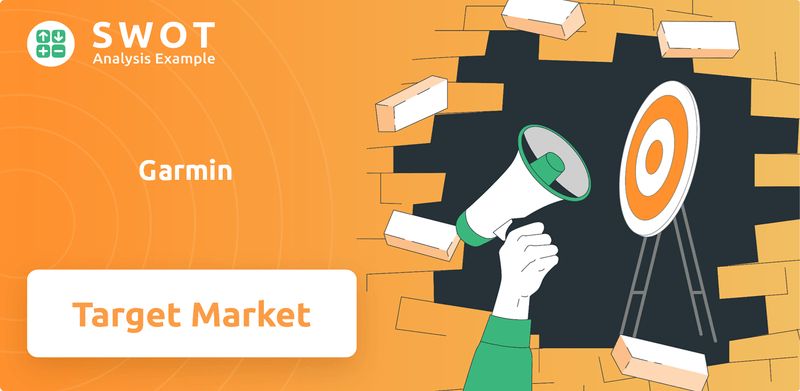
From aviation to fitness, Garmin's evolution reflects its ability to adapt to changing consumer needs. This analysis explores the Garmin customer profile, examining Garmin users across various segments, including Garmin customer age range and Garmin customer income levels. We'll uncover the Garmin target audience for fitness trackers and beyond, providing insights into their purchasing behaviors and preferences, including Garmin customer interests and hobbies.
Who Are Garmin’s Main Customers?
Understanding the customer demographics Garmin serves is crucial for analyzing its market position. The company's reach extends across both consumer (B2C) and business (B2B) sectors, primarily through five key segments: Automotive, Aviation, Marine, Outdoor, and Fitness. This diverse approach allows it to cater to a wide array of users with varying needs and preferences.
Historically, Garmin's B2B operations in aviation and marine were foundational, focusing on pilots, boaters, and original equipment manufacturers (OEMs). These segments often involve professional users who demand high-precision and reliable equipment. Over time, Garmin has strategically expanded its focus, particularly in the B2C segments, to capture a broader market share.
The shift towards B2C segments, especially Outdoor and Fitness, has been a significant growth driver. The Outdoor segment targets active and often affluent individuals who value durability, advanced mapping, and long battery life. The Fitness segment, driven by smartwatches and activity trackers, appeals to a broad demographic, from casual exercisers to serious athletes, all seeking to monitor their health and improve performance.
This segment focuses on providing navigation systems for vehicles. The Garmin target market here includes drivers who seek reliable and user-friendly navigation solutions. This segment offers a wide range of products, from basic GPS devices to advanced infotainment systems.
Caters to pilots and aircraft owners with advanced navigation and communication systems. Garmin customer profile in this segment consists of professional pilots and aviation enthusiasts. This segment is characterized by high-value products and a focus on reliability and precision.
This segment provides navigation and communication solutions for boaters and marine professionals. The Garmin audience here includes boat owners, sailors, and marine businesses. Products range from basic chartplotters to advanced marine electronics.
Focuses on products for outdoor activities like hiking, camping, and hunting. This segment targets outdoor enthusiasts who value durability and advanced features. The Fenix line is a prime example, appealing to serious athletes and adventurers.
This segment is driven by smartwatches and activity trackers, appealing to a broad demographic interested in health and fitness. The Garmin users here include casual exercisers and serious athletes. This segment is experiencing significant growth, as demonstrated by a 13% revenue increase in Q1 2024.
Garmin's customer base is diverse, spanning various age ranges and income levels. Garmin customer age range varies, with younger, tech-savvy consumers (18-45) drawn to smartwatches like the Venu and Forerunner series, while the more rugged Fenix line appeals to serious athletes and outdoor adventurers. The Garmin customer income levels also vary, reflecting the broad range of products and price points offered. The company's market segmentation strategy is designed to cater to these diverse needs.
- Fitness Enthusiasts: This group includes individuals focused on health and wellness, using Garmin devices to track activities and monitor health metrics. They are often motivated by a desire to improve performance and stay connected.
- Outdoor Adventurers: This segment consists of individuals who enjoy outdoor activities like hiking, camping, and hunting. They value durable, feature-rich devices with long battery life and advanced mapping capabilities.
- Professional Pilots and Boaters: This group comprises professionals who rely on Garmin's aviation and marine products for navigation and communication. They prioritize precision, reliability, and advanced features.
- General Consumers: This segment encompasses a broad range of users who purchase Garmin products for general use, such as navigation in vehicles or everyday fitness tracking.
For a deeper understanding of Garmin's strategic moves, consider reading about the Growth Strategy of Garmin. This expansion into new markets and product innovation has helped Garmin maintain its position as a leader in the navigation and wearable technology industries. Garmin's ability to adapt to changing consumer preferences and technological advancements will be key to its continued success.
Garmin SWOT Analysis
- Complete SWOT Breakdown
- Fully Customizable
- Editable in Excel & Word
- Professional Formatting
- Investor-Ready Format
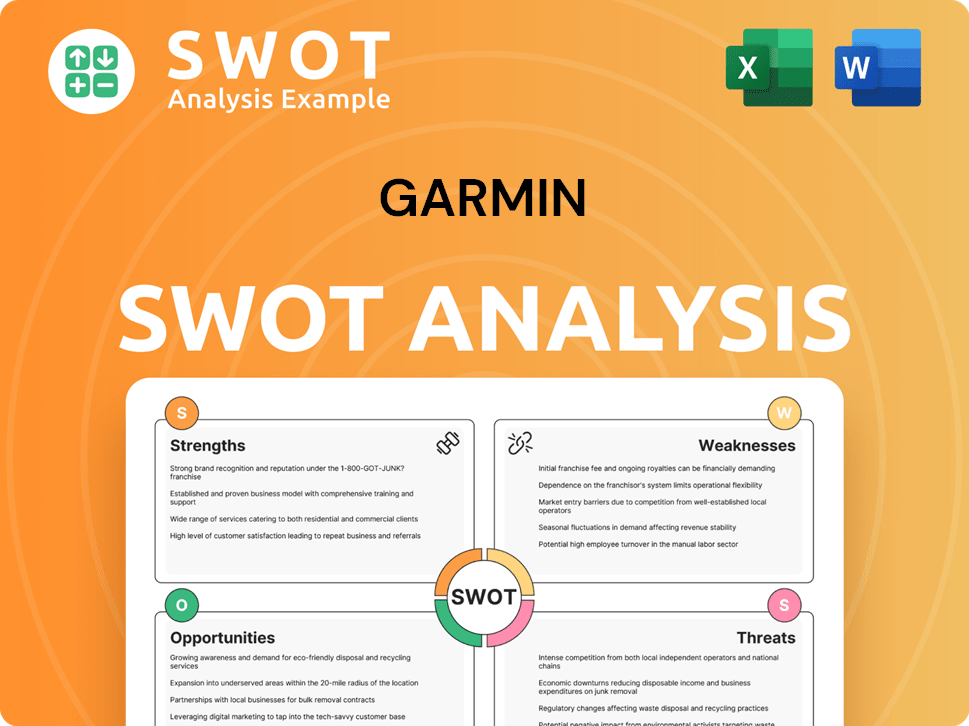
What Do Garmin’s Customers Want?
Understanding the needs and preferences of its diverse customer base is crucial for the success of the company. The company's products cater to a wide range of users, from fitness enthusiasts to outdoor adventurers and aviation professionals. This broad appeal is driven by a focus on providing reliable, accurate data and innovative features that enhance user experiences.
The company's success is rooted in its ability to meet specific customer needs across various segments. Whether it's precise navigation, detailed mapping, or accurate health metrics, the company consistently delivers products that meet these demands. This customer-centric approach allows the company to maintain a strong market position and foster customer loyalty.
The company's customer base is driven by a variety of needs, motivations, and preferences that influence their purchasing decisions. The company's focus on data integrity is a fundamental need across all segments. Practical drivers include battery life, durability, ease of use, and seamless integration with other devices and applications.
Customers in the fitness segment prioritize features like heart rate monitoring, GPS tracking, and sleep analysis. They seek devices that offer actionable insights into their health and performance. The company addresses these needs by continuously updating its software and introducing new metrics.
Outdoor enthusiasts value robust construction, advanced mapping, and satellite communication. The company's inReach devices cater to the critical need for communication beyond cellular service. The company's products meet the demands of adventurers seeking reliable and durable gear.
Aviation and marine customers require precise navigation, reliable data, and durable equipment. The company provides advanced navigation systems and communication tools. These products are designed to meet the demanding requirements of professionals and enthusiasts.
The company uses customer feedback and market trends to inform product development. This leads to innovations like the inclusion of ECG capabilities in some smartwatches. This approach ensures that the company stays ahead of customer needs.
The company tailors its marketing to highlight the benefits of its devices. It showcases how its products empower users to achieve their fitness goals and enhance their outdoor experiences. This targeted approach resonates with specific customer segments.
The company's focus on customer needs and preferences fosters loyalty and repeat purchases. By consistently delivering on its promises, the company builds trust with its customers. This loyalty is a key factor in the company's long-term success.
The company's ability to understand and cater to its customers' needs is a key driver of its success. The company's products are designed to meet the specific requirements of various user groups, from fitness enthusiasts to outdoor adventurers and aviation professionals. This customer-centric approach allows the company to maintain a strong market position. The company's commitment to innovation and customer satisfaction is evident in its product development and marketing strategies. For a deeper dive into the competitive landscape, consider exploring the Competitors Landscape of Garmin.
The company's customers across various segments share common needs, including reliable data, durable products, and ease of use. The company's product development is heavily influenced by customer feedback and market trends.
- Reliable Data: Accuracy is a fundamental requirement for all users, whether for navigation, health metrics, or outdoor activities.
- Durability: Products must withstand harsh conditions, especially for outdoor and marine users.
- Ease of Use: Devices should be intuitive and easy to operate, regardless of the user's technical expertise.
- Integration: Seamless integration with other devices and applications enhances the user experience.
- Advanced Features: Customers seek advanced features like satellite communication, ECG capabilities, and comprehensive health tracking.
Garmin PESTLE Analysis
- Covers All 6 PESTLE Categories
- No Research Needed – Save Hours of Work
- Built by Experts, Trusted by Consultants
- Instant Download, Ready to Use
- 100% Editable, Fully Customizable
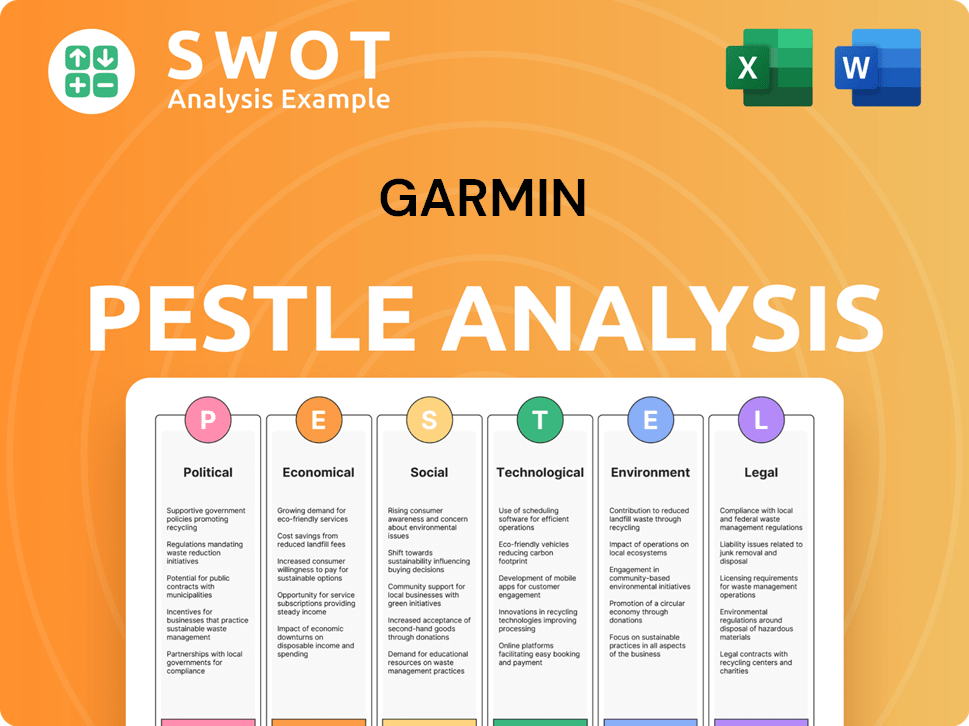
Where does Garmin operate?
The company maintains a significant global geographical market presence, with a strong foothold in North America, Europe, and the Asia-Pacific region. This widespread presence allows the company to cater to a diverse customer base and capitalize on varying market demands. The United States remains a key market, particularly for outdoor, fitness, and aviation products, where the brand enjoys high recognition.
Europe is another substantial market, with countries like the UK, Germany, and France showing high adoption rates for fitness wearables and cycling computers. In the Asia-Pacific region, Australia, Japan, and China are crucial, each presenting unique preferences and growth opportunities. This strategic geographical distribution ensures the company can effectively meet the diverse demands of global consumers, contributing to consistent revenue streams.
The company's approach involves localized strategies to address differences in customer demographics, preferences, and buying power across regions. This includes language support, regional mapping data, and partnerships with local retailers. Marketing campaigns are also tailored to resonate with cultural nuances and regional interests. This approach helps the company maintain and grow its market share worldwide. For more insights, explore the Growth Strategy of Garmin.
The United States is a primary market, especially for outdoor, fitness, and aviation products. The company has a strong brand recognition and a loyal customer base here. This region shows significant demand for high-endurance and technologically advanced devices.
Europe represents a substantial market, with countries like the UK, Germany, and France showing high adoption rates. Fitness wearables and cycling computers are particularly popular. The company tailors its offerings to meet the specific needs of European consumers.
The Asia-Pacific region, including Australia, Japan, and China, is a key market with varying preferences. The demand for smart wearables is rapidly growing in this region. The company focuses on localized strategies to capture market share.
Localized strategies include language support, regional mapping, and partnerships with local retailers. Marketing campaigns are tailored to cultural nuances. The company actively participates in regional trade shows to strengthen its brand presence.
The company's revenue for Q1 2024 was USD 1.2 billion, with contributions from all segments across various geographies. The Asia-Pacific smart wearable market is projected to reach USD 100.9 billion by 2029. Understanding the needs of the company's users is crucial for continued success.
- North America: Strong demand for outdoor and fitness products.
- Europe: High adoption of fitness wearables and cycling computers.
- Asia-Pacific: Rapid growth in smart wearable demand.
- Localized Approach: Tailored strategies for each region.
Garmin Business Model Canvas
- Complete 9-Block Business Model Canvas
- Effortlessly Communicate Your Business Strategy
- Investor-Ready BMC Format
- 100% Editable and Customizable
- Clear and Structured Layout
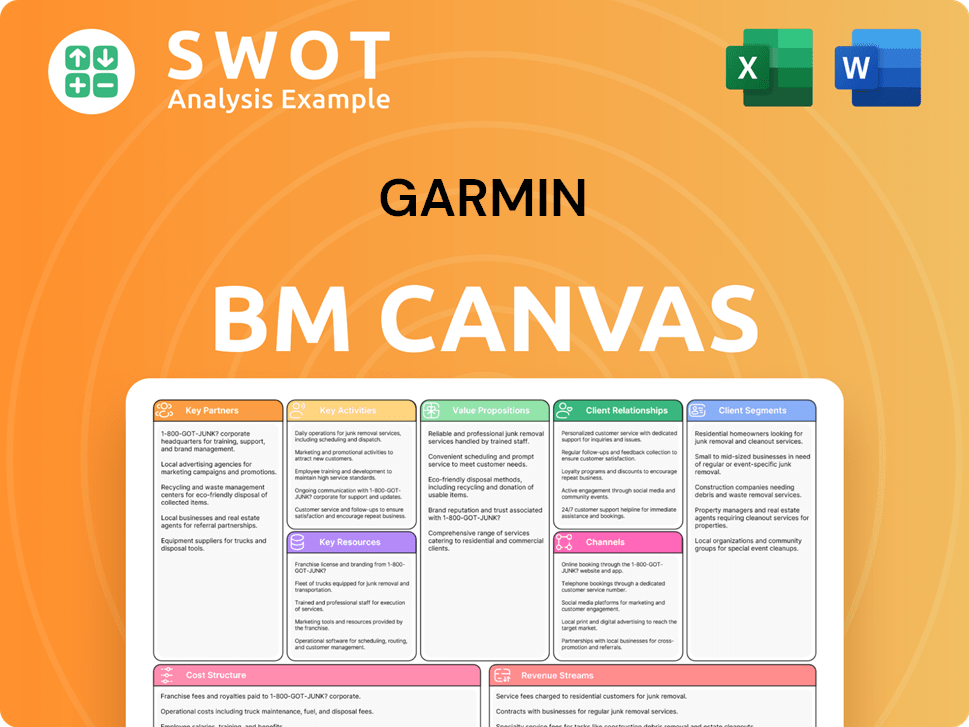
How Does Garmin Win & Keep Customers?
The company's customer acquisition and retention strategies are designed to attract and keep a diverse customer base engaged with its products and services. These strategies include a mix of digital marketing, social media engagement, and strategic partnerships. The company focuses on building a strong brand presence and fostering a loyal customer community.
The company uses a multi-faceted approach to reach its target market, including online advertising, search engine optimization (SEO), and content marketing. Social media campaigns on platforms like Instagram, Facebook, and YouTube are used to showcase product features and engage with the active lifestyle community. Influencer marketing is also a key strategy to reach specific niche audiences and build brand credibility.
For customer retention, the company emphasizes building a strong ecosystem around its products. This includes the company's Connect platform, a central hub for users to track activities, analyze data, set goals, and connect with other users, fostering a sense of community and encouraging continued engagement with the company's devices. This focus on long-term relationships and continuous value addition helps to reduce churn and increase customer lifetime value.
The company employs targeted online advertising to reach potential customers. Search engine optimization (SEO) is used to improve online visibility. Content marketing is utilized to drive traffic to the company's website and e-commerce platforms.
Social media campaigns are run on platforms like Instagram, Facebook, and YouTube. These campaigns showcase product features and user success stories. The company engages with the active lifestyle community through social media.
Influencer marketing is a key strategy to reach specific niche audiences. The company partners with athletes, adventurers, and health professionals. This builds brand credibility and expands market reach.
The company focuses on building a strong ecosystem around its products. The platform, Connect, is a central hub for users. Loyalty programs are embedded in software updates and new feature releases.
The company's customer acquisition and retention strategies are crucial for its continued success. Understanding the Revenue Streams & Business Model of Garmin can provide further insights into the financial implications of these strategies. The company's focus on digital marketing, social media engagement, and influencer partnerships helps to attract new customers. The emphasis on customer retention through the Connect platform, software updates, and personalized experiences fosters loyalty and reduces customer churn. By combining these strategies, the company aims to maintain a strong customer base and drive long-term growth.
Garmin Porter's Five Forces Analysis
- Covers All 5 Competitive Forces in Detail
- Structured for Consultants, Students, and Founders
- 100% Editable in Microsoft Word & Excel
- Instant Digital Download – Use Immediately
- Compatible with Mac & PC – Fully Unlocked
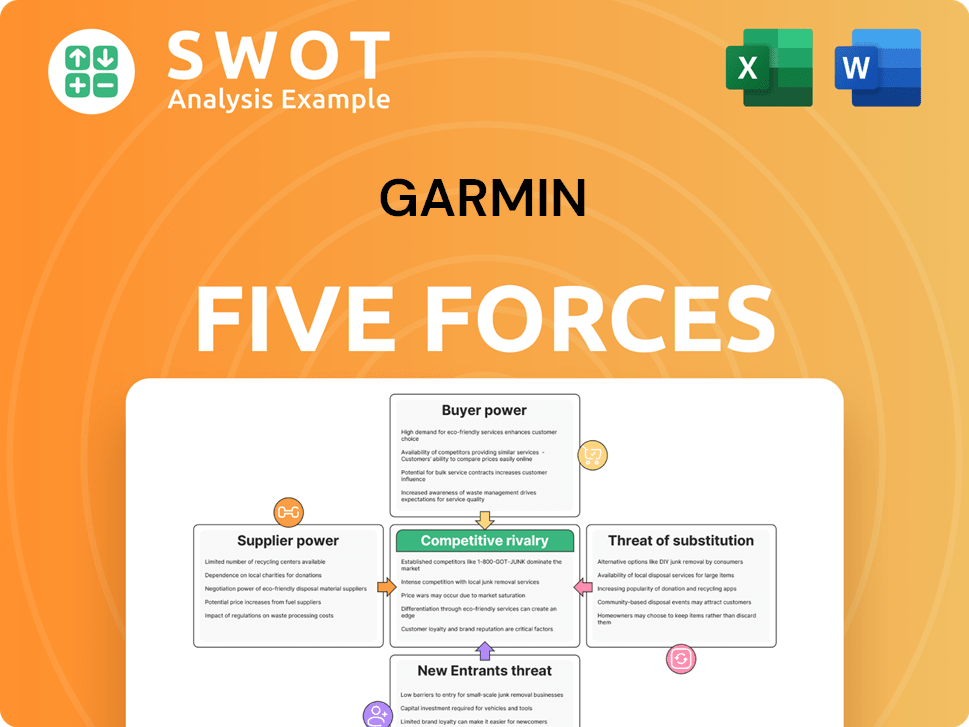
Related Blogs
- What are Mission Vision & Core Values of Garmin Company?
- What is Competitive Landscape of Garmin Company?
- What is Growth Strategy and Future Prospects of Garmin Company?
- How Does Garmin Company Work?
- What is Sales and Marketing Strategy of Garmin Company?
- What is Brief History of Garmin Company?
- Who Owns Garmin Company?
Disclaimer
All information, articles, and product details provided on this website are for general informational and educational purposes only. We do not claim any ownership over, nor do we intend to infringe upon, any trademarks, copyrights, logos, brand names, or other intellectual property mentioned or depicted on this site. Such intellectual property remains the property of its respective owners, and any references here are made solely for identification or informational purposes, without implying any affiliation, endorsement, or partnership.
We make no representations or warranties, express or implied, regarding the accuracy, completeness, or suitability of any content or products presented. Nothing on this website should be construed as legal, tax, investment, financial, medical, or other professional advice. In addition, no part of this site—including articles or product references—constitutes a solicitation, recommendation, endorsement, advertisement, or offer to buy or sell any securities, franchises, or other financial instruments, particularly in jurisdictions where such activity would be unlawful.
All content is of a general nature and may not address the specific circumstances of any individual or entity. It is not a substitute for professional advice or services. Any actions you take based on the information provided here are strictly at your own risk. You accept full responsibility for any decisions or outcomes arising from your use of this website and agree to release us from any liability in connection with your use of, or reliance upon, the content or products found herein.